Quantitative Imaging of Gd Nanoparticles in Mice Using Benchtop Cone-Beam X-ray Fluorescence Computed Tomography System
Abstract
:1. Introduction
2. Results
2.1. XFCT Imaging of a PMMA Phantom
2.2. XFCT Imaging of Mice
3. Discussion
4. Materials and Methods
4.1. Benchtop XFCT Device
4.2. Animal Handling and Tumor Generation
4.3. NaGdF4 NPs
4.4. Cone Beam CT and XFCT
4.5. Data Acqusition and Image Reconstruction
Author Contributions
Funding
Conflicts of Interest
References
- Maeda, H.; Fang, J.; Inutsuka, T.; Kitamoto, Y. Vascular permeability enhancement in solid tumor: Various factors, mechanisms involved and its implications. Int. Immunopharmacol. 2003, 3, 319–328. [Google Scholar] [CrossRef]
- Iyer, A.K.; Khaled, G.; Fang, J.; Maeda, H. Exploiting the enhanced permeability and retention effect for tumor targeting. Drug Discov. Today 2006, 11, 812–818. [Google Scholar] [CrossRef] [PubMed]
- Wolfbeis, O.S. An overview of nanoparticles commonly used in fluorescent bioimaging. Chem. Soc. Rev. 2015, 44, 4743–4768. [Google Scholar] [CrossRef] [PubMed] [Green Version]
- Weissleder, R. A clearer vision for in vivo imaging. Nature Biotechnol. 2001, 19, 316–317. [Google Scholar] [CrossRef] [PubMed]
- Hilderbrand, S.A.; Weissleder, R. Near-infrared fluorescence: Application to in vivo molecular imaging. Curr. Opin. Chem. Biol. 2010, 14, 71–79. [Google Scholar] [CrossRef]
- Ntziachristos, V.; Bremer, C.; Weissleder, R. Fluorescence imaging with near-infrared light: New technological advances that enable in vivo molecular imaging. Eur. Radiol. 2003, 13, 195–208. [Google Scholar] [PubMed]
- Bazalova, M.; Kuang, Y.; Pratx, G.; Xing, L. Investigation of X-ray fluorescence computed tomography (xfct) and k-edge imaging. IEEE Trans. Med Imaging 2012, 31, 1620–1627. [Google Scholar] [CrossRef]
- Feng, P.; Cong, W.; Wei, B.; Wang, G. Analytic comparison between X-ray fluorescence ct and k-edge ct. IEEE Trans. Biomed. Eng. 2014, 61, 975–985. [Google Scholar] [CrossRef]
- Boisseau, P.; Grodzins, L. Fluorescence tomography using synchrotron radiation at the nsls. Hyperfine Interact. 1987, 33, 283–292. [Google Scholar] [CrossRef]
- Takeda, T.; Yu, Q.W.; Yashiro, T.; Yuasa, T.; Hasegawa, Y.; Itai, Y.; Akatsuka, T. Human thyroid specimen imaging by fluorescent X-ray computed tomography with synchrotron radiation. In Developments in X-ray Tomography ii; Bonse, U., Ed.; SPIE: Bellingham, WA, USA, 1999; Volume 3772, pp. 258–267. [Google Scholar]
- Deng, B.; Du, G.; Zhou, G.; Wang, Y.; Ren, Y.; Chen, R.; Sun, P.; Xie, H.; Xiao, T. 3d elemental sensitive imaging by full-field xfct. Analyst 2015, 140, 3521–3525. [Google Scholar] [CrossRef]
- Meng, L.J.; Li, N.; La Riviere, P.J. X-ray fluorescence emission tomography (xfet) with novel imaging geometries-a monte carlo study. IEEE Trans. Nucl. Sci. 2011, 58, 3359–3369. [Google Scholar] [CrossRef]
- Sasaya, T.; Sunaguchi, N.; Thet Thet, L.; Hyodo, K.; Zeniya, T.; Takeda, T.; Yuasa, T. Dual-energy fluorescent X-ray computed tomography system with a pinhole design: Use of k-edge discontinuity for scatter correction. Sci. Rep. 2017, 7. [Google Scholar] [CrossRef]
- Cong, W.; Shen, H.; Cao, G.; Liu, H.; Wang, G. X-ray fluorescence tomographic system design and image reconstruction. J. X-ray Sci. Technol. 2013, 21, 1–8. [Google Scholar]
- Jones, B.L.; Manohar, N.; Reynoso, F.; Karellas, A.; Cho, S.H. Experimental demonstration of benchtop X-ray fluorescence computed tomography (xfct) of gold nanoparticle-loaded objects using lead- and tin-filtered polychromatic cone-beams. Phys. Med. Biol. 2012, 57, N457–N467. [Google Scholar] [CrossRef] [PubMed]
- Manohar, N.; Reynoso, F.J.; Cho, S.H. Experimental demonstration of direct l-shell X-ray fluorescence imaging of gold nanoparticles using a benchtop X-ray source. Med Phys. 2013, 40. [Google Scholar] [CrossRef]
- Ahmad, M.; Bazalova, M.; Xiang, L.; Xing, L. Order of magnitude sensitivity increase in X-ray fluorescence computed tomography (xfct) imaging with an optimized spectro-spatial detector configuration: Theory and simulation. IEEE Trans. Med Imaging 2014, 33, 1119–1128. [Google Scholar] [CrossRef] [PubMed]
- Manohar, N.; Jones, B.L.; Cho, S.H. Improving X-ray fluorescence signal for benchtop polychromatic cone-beam X-ray fluorescence computed tomography by incident X-ray spectrum optimization: A monte carlo study. Med Phys. 2014, 41. [Google Scholar] [CrossRef]
- Groll, A.; George, J.; Vargas, P.; La Riviere, P.J.; Meng, L.J. Element mapping in organic samples utilizing a benchtop X-ray fluorescence emission tomography (xfet) system. IEEE Trans. Nucl. Sci. 2015, 62, 2310–2317. [Google Scholar] [CrossRef] [PubMed]
- Ahmad, M.; Bazalova-Carter, M.; Fahrig, R.; Xing, L. Optimized detector angular configuration increases the sensitivity of X-ray fluorescence computed tomography (xfct). IEEE Trans. Med Imaging 2015, 34, 1140–1147. [Google Scholar] [CrossRef]
- Jones, B.L.; Cho, S.H. The feasibility of polychromatic cone-beam X-ray fluorescence computed tomography (xfct) imaging of gold nanoparticle-loaded objects: A monte carlo study. Phys. Med. Biol. 2011, 56, 3719–3730. [Google Scholar] [CrossRef]
- Li, L.; Li, R.; Zhang, S.; Chen, Z. Simultaneous X-ray fluorescence and k-edge ct imaging with photon-counting detectors. In Developments in X-ray Tomography x; Stock, S.R., Muller, B., Wang, G., Eds.; SPIE: Bellingham, WA, USA, 2016; Volume 9967. [Google Scholar]
- Cong, W.; Wang, G. X-ray Fluorescence Sectioning. arXiv 2012, arXiv:1210.7198. [Google Scholar]
- Ren, L.; Ghani, M.U.; Wu, D.; Li, Y.; Chen, W.R.; Wang, G.; Zheng, B.; Liu, H. Characteristic performance investigation of a photon counting detector for X-ray fluorescence imaging applications. In Biophotonics and Immune Responses xii; Chen, W.R., Ed.; SPIE: Bellingham, WA, USA, 2017; Volume 10065. [Google Scholar]
- Manohar, N.; Reynoso, F.J.; Cho, S.H. Technical note: A benchtop cone-beam X-ray fluorescence computed tomography (xfct) system with a high-power X-ray source and transmission ct imaging capability. Med Phys. 2018, 45, 4652–4659. [Google Scholar] [CrossRef] [PubMed]
- Cheong, S.-K.; Jones, B.L.; Siddiqi, A.K.; Liu, F.; Manohar, N.; Cho, S.H. X-ray fluorescence computed tomography (xfct) imaging of gold nanoparticle-loaded objects using 110 kvp X-rays. Phys. Med. Biol. 2010, 55, 647–662. [Google Scholar] [CrossRef] [PubMed]
- Kuang, Y.; Pratx, G.; Bazalova, M.; Qian, J.; Meng, B.; Xing, L. Development of xfct imaging strategy for monitoring the spatial distribution of platinum-based chemodrugs: Instrumentation and phantom validation. Med Phys. 2013, 40. [Google Scholar] [CrossRef]
- Kuang, Y.; Pratx, G.; Bazalova, M.; Meng, B.; Qian, J.; Xing, L. First demonstration of multiplexed X-ray fluorescence computed tomography (xfct) imaging. IEEE Trans. Med Imaging 2013, 32, 262–267. [Google Scholar] [CrossRef]
- Deng, L.Z.; Wei, B.; He, P.; Zhang, Y.; Feng, P. A geant4-based monte carlo study of a benchtop multi-pinhole X-ray fluorescence computed tomography imaging. Int. J. Nanomed. 2018, 13, 7207–7216. [Google Scholar] [CrossRef] [PubMed]
- Manohar, N.; Reynoso, F.J.; Diagaradjane, P.; Krishnan, S.; Cho, S.H. Quantitative imaging of gold nanoparticle distribution in a tumor-bearing mouse using benchtop X-ray fluorescence computed tomography. Sci. Rep. 2016, 6. [Google Scholar] [CrossRef]
- Oyewumi, M.O.; Yokel, R.A.; Jay, M.; Coakley, T.; Mumper, R.J. Comparison of cell uptake, biodistribution and tumor retention of folate-coated and peg-coated gadolinium nanoparticles in tumor-bearing mice. J. Control. Release 2004, 95, 613–626. [Google Scholar] [CrossRef] [PubMed]
- Raymond, K.N.; Pierre, V.C. Next generation, high relaxivity gadolinium mr1 agents. Bioconjugate Chem. 2005, 16, 3–8. [Google Scholar] [CrossRef]
- Rose, A. Vision-human and electronic. In 1976 SID International Symposium Digest of Technical Papers; Winner: New York, NY, USA, 1976; p. 13. [Google Scholar]
- Sasaya, T.; Sunaguchi, N.; Hyodo, K.; Zeniya, T.; Yuasa, T. Multi-pinhole fluorescent X-ray computed tomography for molecular imaging. Sci. Rep. 2017, 7. [Google Scholar] [CrossRef]
- Lee, D.-E.; Koo, H.; Sun, I.-C.; Ryu, J.H.; Kim, K.; Kwon, I.C. Multifunctional nanoparticles for multimodal imaging and theragnosis. Chem. Soc. Rev. 2012, 41, 2656–2672. [Google Scholar] [CrossRef]
- Chen, G.; Ohulchanskyy, T.Y.; Liu, S.; Law, W.-C.; Wu, F.; Swihart, M.T.; Agren, H.; Prasad, P.N. Core/shell nagdf4:Nd3+/nagdf4 nanocrystals with efficient near-infrared to near-infrared downconversion photoluminescence for bioimaging applications. Acs Nano 2012, 6, 2969–2977. [Google Scholar] [CrossRef]
- Zhang, W.; Shen, Y.; Liu, M.; Gao, P.; Pu, H.; Fan, L.; Jiang, R.; Liu, Z.; Shi, F.; Lu, H. Sub-10 nm water-dispersible beta-nagdf4:X% eu3+ nanoparticles with enhanced biocompatibility for in vivo X-ray luminescence computed tomography. Acs Appl. Mater. Interfaces 2017, 9, 39985–39993. [Google Scholar] [CrossRef] [PubMed]
- Vernekohl, D.; Tzoumas, S.; Zhao, W.; Xing, L. Polarized X-ray excitation for scatter reduction in X-ray fluorescence computed tomography. Med. Phys. 2018, 45, 3741–3748. [Google Scholar] [CrossRef] [PubMed]
- Zhang, W.; Zhang, X.; Shen, Y.; Shi, F.; Song, C.; Liu, T.; Gao, P.; Lan, B.; Liu, M.; Wang, S.; et al. Ultra-high fret efficiency nagdf4: Tb3+-rose bengal biocompatible nanocomposite for X-ray excited photodynamic therapy application. Biomaterials 2018, 184, 31–40. [Google Scholar] [CrossRef]
- Feldkamp, L.A.; Davis, L.C.; Kress, J.W. Practical cone-beam algorithm. J. Opt. Soc. Am. A-Opt. Image Sci. Vis. 1984, 1, 612–619. [Google Scholar] [CrossRef]
- Poludniowski, G.; Landry, G.; DeBlois, F.; Evans, P.M.; Verhaegen, F. Spekcalc: A program to calculate photon spectra from tungsten anode X-ray tubes. Phys. Med. Biol. 2009, 54, N433–N438. [Google Scholar] [CrossRef]
- Nist standard reference database 126. Available online: https://www.nist.gov/pml/X-ray-mass-attenuation-coefficients (accessed on 9 May 2019).
- Zhang, S.; Li, L.; Li, R.; Chen, Z. Full-field fan-beam X-ray fluorescence computed tomography system design with linear-array detectors and pinhole collimation: A rapid monte carlo study. Opt. Eng. 2017, 56. [Google Scholar] [CrossRef]
- Lange, K.; Carson, R. Em reconstruction algorithms for emission and transmission tomography. J. Comput. Assist. Tomogr. 1984, 8, 306–316. [Google Scholar] [PubMed]
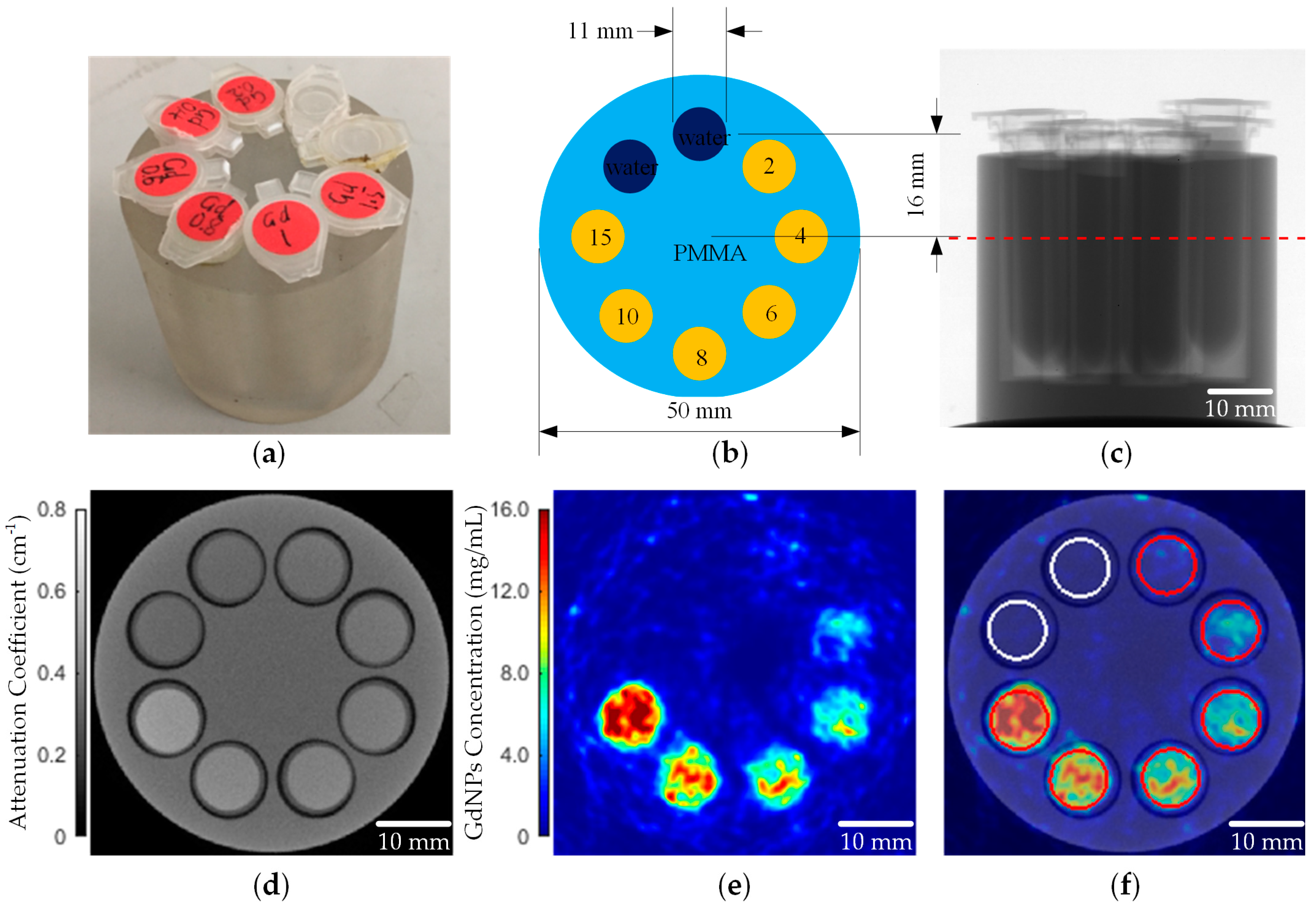
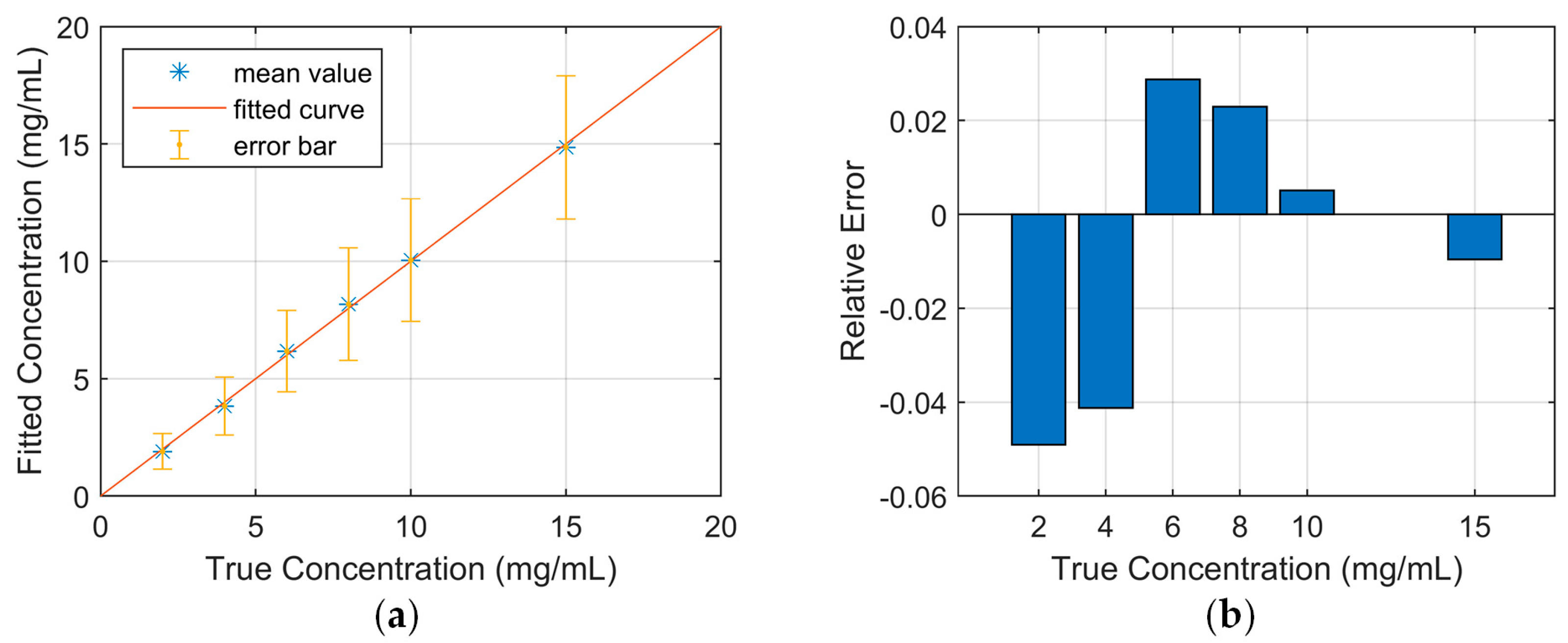
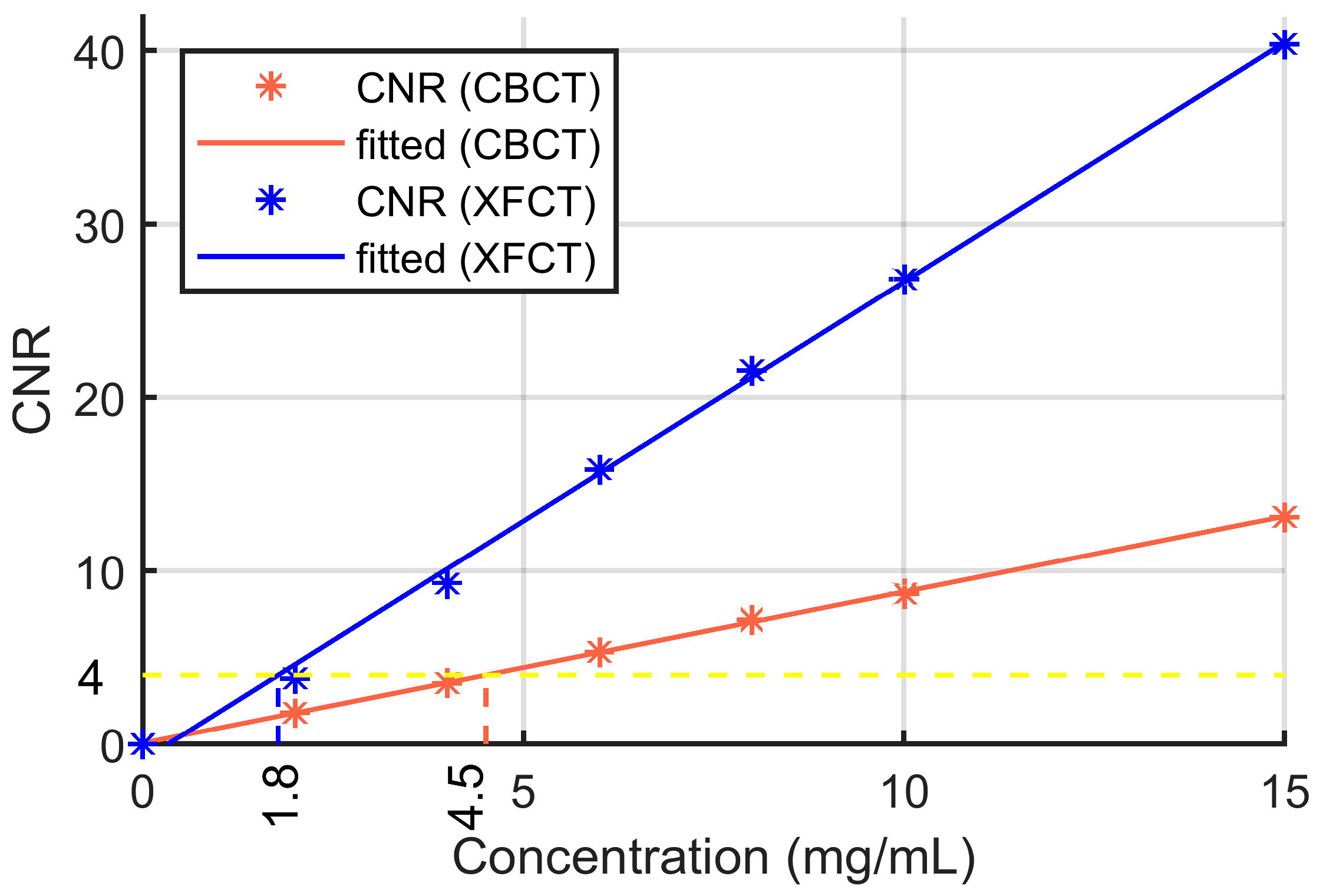


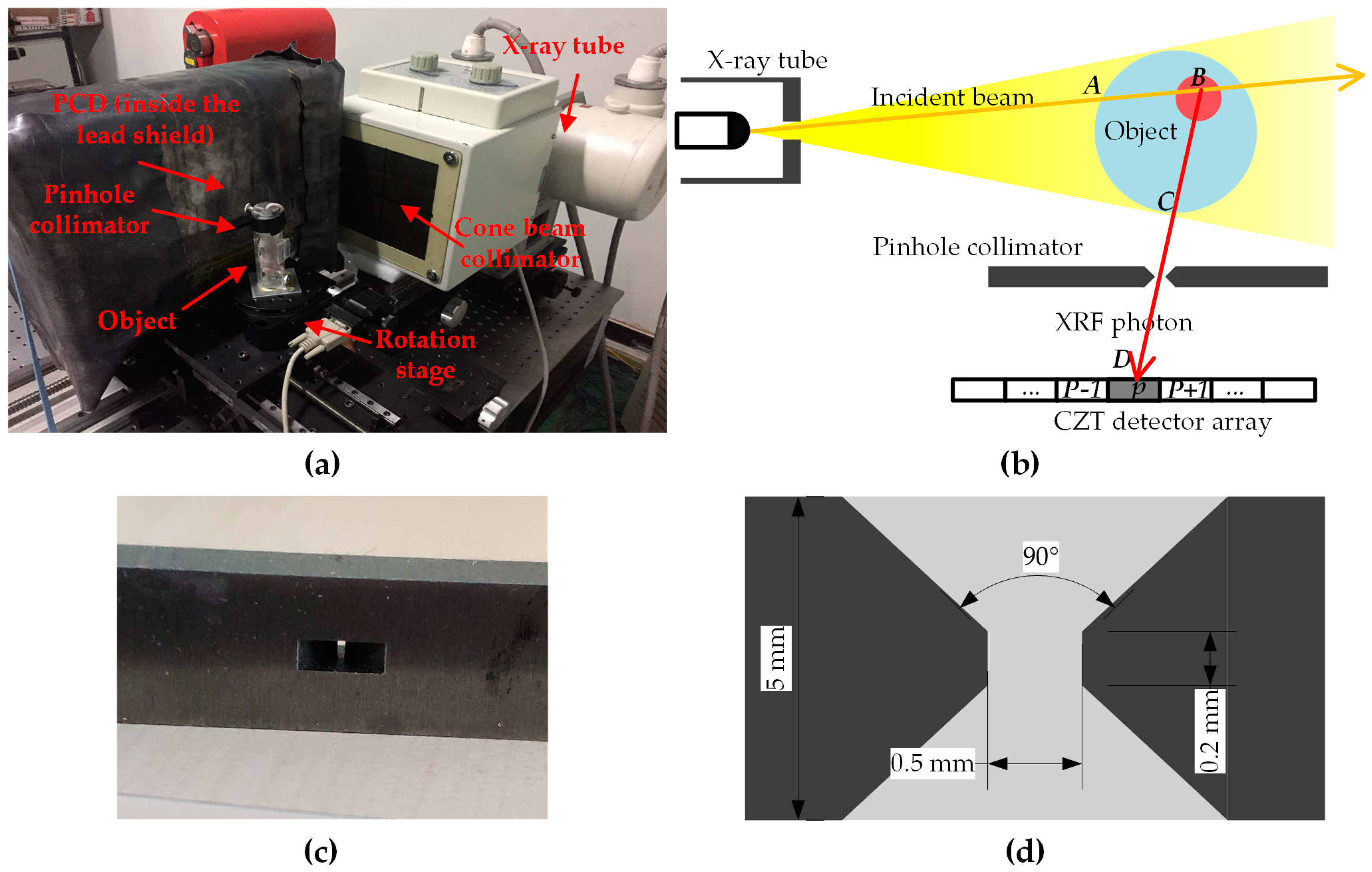
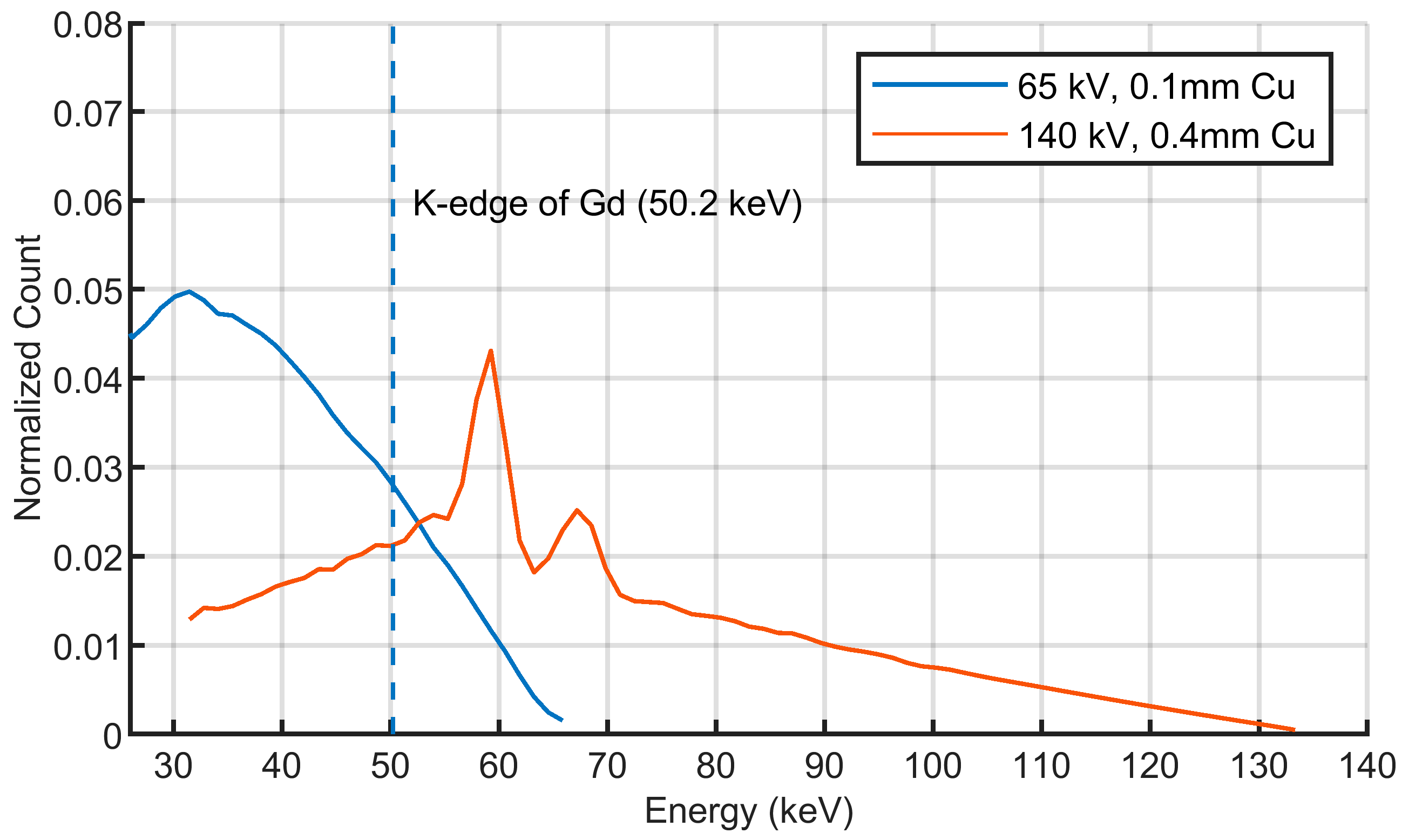

| Slice | Organ | Highest Concentration (mg/mL) |
|---|---|---|
| 1 | Noncancerous liver | 7.94 |
| 2 | Noncancerous liver | 5.30 |
| 3 | Kidney | 2.51 |
| 4 | Cancerous liver | 4.16 |
| 5 | Tumor in the hind leg | 7.13 |
© 2019 by the authors. Licensee MDPI, Basel, Switzerland. This article is an open access article distributed under the terms and conditions of the Creative Commons Attribution (CC BY) license (http://creativecommons.org/licenses/by/4.0/).
Share and Cite
Zhang, S.; Li, L.; Chen, J.; Chen, Z.; Zhang, W.; Lu, H. Quantitative Imaging of Gd Nanoparticles in Mice Using Benchtop Cone-Beam X-ray Fluorescence Computed Tomography System. Int. J. Mol. Sci. 2019, 20, 2315. https://0-doi-org.brum.beds.ac.uk/10.3390/ijms20092315
Zhang S, Li L, Chen J, Chen Z, Zhang W, Lu H. Quantitative Imaging of Gd Nanoparticles in Mice Using Benchtop Cone-Beam X-ray Fluorescence Computed Tomography System. International Journal of Molecular Sciences. 2019; 20(9):2315. https://0-doi-org.brum.beds.ac.uk/10.3390/ijms20092315
Chicago/Turabian StyleZhang, Siyuan, Liang Li, Jiayou Chen, Zhiqiang Chen, Wenli Zhang, and Hongbing Lu. 2019. "Quantitative Imaging of Gd Nanoparticles in Mice Using Benchtop Cone-Beam X-ray Fluorescence Computed Tomography System" International Journal of Molecular Sciences 20, no. 9: 2315. https://0-doi-org.brum.beds.ac.uk/10.3390/ijms20092315





